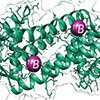May 09, 2024
(Nanowerk News) Boronic acid has been used in organic chemistry for decades, even though it is not present in any organism. ‘It gives rise to different chemical reactions than those we find in nature,’ explains Gerard Roelfes, Professor of Biomolecular Chemistry & Catalysis at the University of Groningen. His group created an enzyme with boronic acid at its reactive centre and then used directed evolution to make it more selective and to improve its catalytic power. Furthermore, enzymatic reactions are more sustainable than classical chemical reactions, as they take place at low temperatures and without toxic solvents.
The study was presented in the journal Nature (“Boron catalysis in a designer enzyme”).
 University of Groningen chemists introduced an artificial amino acid containing boron in an enzyme. (Illustration: Roelfes Lab)
The application of boron in organic chemistry dates back some seventy years and was awarded a Nobel Prize for Chemistry in 1979. In recent years, the interest in boron as a catalyst has grown, but as yet, its use in the chemical industry is limited.
Roelfes: ‘So far, boron catalysis is too slow and it is not very suitable for enantioselective reactions.’ These types of reactions are used to create chiral molecules, which can exist in two versions that are mirror images of each other, like a left and a right hand. In many drugs, both ‘hands’ can have a different effect. It is, therefore, important to selectively produce the proper ‘hand’, especially for the pharmaceutical industry.
University of Groningen chemists introduced an artificial amino acid containing boron in an enzyme. (Illustration: Roelfes Lab)
The application of boron in organic chemistry dates back some seventy years and was awarded a Nobel Prize for Chemistry in 1979. In recent years, the interest in boron as a catalyst has grown, but as yet, its use in the chemical industry is limited.
Roelfes: ‘So far, boron catalysis is too slow and it is not very suitable for enantioselective reactions.’ These types of reactions are used to create chiral molecules, which can exist in two versions that are mirror images of each other, like a left and a right hand. In many drugs, both ‘hands’ can have a different effect. It is, therefore, important to selectively produce the proper ‘hand’, especially for the pharmaceutical industry.
 University of Groningen chemists introduced an artificial amino acid containing boron in an enzyme. (Illustration: Roelfes Lab)
The application of boron in organic chemistry dates back some seventy years and was awarded a Nobel Prize for Chemistry in 1979. In recent years, the interest in boron as a catalyst has grown, but as yet, its use in the chemical industry is limited.
Roelfes: ‘So far, boron catalysis is too slow and it is not very suitable for enantioselective reactions.’ These types of reactions are used to create chiral molecules, which can exist in two versions that are mirror images of each other, like a left and a right hand. In many drugs, both ‘hands’ can have a different effect. It is, therefore, important to selectively produce the proper ‘hand’, especially for the pharmaceutical industry.
University of Groningen chemists introduced an artificial amino acid containing boron in an enzyme. (Illustration: Roelfes Lab)
The application of boron in organic chemistry dates back some seventy years and was awarded a Nobel Prize for Chemistry in 1979. In recent years, the interest in boron as a catalyst has grown, but as yet, its use in the chemical industry is limited.
Roelfes: ‘So far, boron catalysis is too slow and it is not very suitable for enantioselective reactions.’ These types of reactions are used to create chiral molecules, which can exist in two versions that are mirror images of each other, like a left and a right hand. In many drugs, both ‘hands’ can have a different effect. It is, therefore, important to selectively produce the proper ‘hand’, especially for the pharmaceutical industry.

